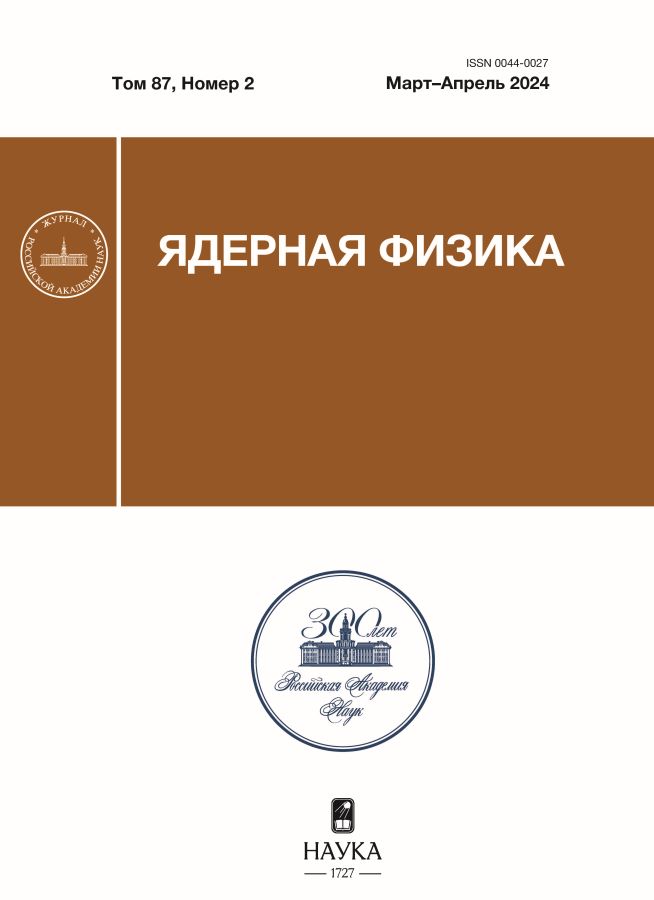Study of cosmic rays with energies above 5 EeV using radio method
- Авторлар: Petrov I.S.1, Knurenko S.P.1
-
Мекемелер:
- Yu.G. Shafer Institute of Cosmophysical Research and Aeronomy of Siberian Branch of the Russian Academy of Sciences
- Шығарылым: Том 87, № 2 (2024)
- Беттер: 79-85
- Бөлім: ЭЛЕМЕНТАРНЫЕ ЧАСТИЦЫ И ПОЛЯ. Эксперимент
- ##submission.datePublished##: 07.10.2024
- URL: https://cardiosomatics.ru/0044-0027/article/view/674659
- DOI: https://doi.org/10.31857/S0044002724020029
- EDN: https://elibrary.ru/KRWDGO
- ID: 674659
Дәйексөз келтіру
Аннотация
At the Yakutsk array in 1986 regular measurements of radio emission produced by relativistic air shower particles were started. After monitoring of background noise in the array area frequency of 30–35 MHz was chosen, since noise level is minimal in this frequency range. During this time, air showers with highest energies of 100 EeV were registered. By using hybrid measurements of charged particles, Cherenkov light and radio emission it was shown that signal amplitude proportional to air shower energy and shape of lateral distribution at sea level correlates with the depth of maximum development. Using the obtained characteristics, atomic weight of primary particles that generated air shower was estimated within QGSjetII-04 framework simulation.
Толық мәтін
Авторлар туралы
I. Petrov
Yu.G. Shafer Institute of Cosmophysical Research and Aeronomy of Siberian Branch of the Russian Academy of Sciences
Хат алмасуға жауапты Автор.
Email: igor.petrov@ikfia.ysn.ru
Ресей, Yakutsk
S. Knurenko
Yu.G. Shafer Institute of Cosmophysical Research and Aeronomy of Siberian Branch of the Russian Academy of Sciences
Email: igor.petrov@ikfia.ysn.ru
Ресей, Yakutsk
Әдебиет тізімі
- А. Д. Филоненко, УФН 185, 673 (2015) [Phys. Usp. 58, 633 (2015)].
- В. А. Царев, ЭЧАЯ 35, 1 (2004).
- J. Linsley, Phys. Rev. Lett. 10, 146 (1963).
- J. V. Jelley, J. H. Fruin, N. A. Porter, T. C. Weekes, F. G. Smith, and R. A. Porter, Nature 205, 327 (1965).
- F. D. Kahn and I. Lerche, Proc. Roy. Soc. London Ser. A 289, 206 (1966).
- O. Scholten, K. Werner, and F. Rusydi, Astropart. Phys. 29, 94 (2008).
- G. A. Askaryan, Sov. Phys. JETP 14, 441 (1962).
- F. G. Schröder, Prog. Part. Nucl. Phys. 93, 1 (2017).
- V. P. Artamonov, T. A. Egorov, N. N. Efimov, T. V. Rekhlyasova, N. I. Sleptsov, S. A. Shudrya, and V. B. Atrashkevich, in Proceedings of the 21st ICRC, Adelaide, Australia (1990), Vol. 9, p. 210.
- L. G. Dedenko, A. V. Glushkov, S. P. Knurenko, I. T. Makarov, M. I. Pravdin, D. A. Podgrudkov, I. E. Sleptsov, T. M. Roganova, and G. F. Fedorova, JETP Lett. 90, 787 (2009).
- S. Knurenko, V. Kozlov, Z. Petrov, M. Pravdin, and A. Sabourov, in Proceedings of the 22nd ECRS, Turku, Finland (2010), p. 262.
- S. P. Knurenko, Z. E. Petrov, and I. S. Petrov, Nucl. Instum. Methods A 866, 230 (2017).
- Р. Р. Каримов, С. П. Кнуренко, В. И. Козлов, И. Т. Макаров, З. Е. Петров, М. И. Правдин, А. А. Торопов, Материалы XVI международного симпозиума (Томск, Россия, 2009), с. 602.
- S. P. Knurenko, D. S. Borschevsky, Z. E. Petrov, and I. S. Petrov, Proc. SPIE 8696, 86960Q (2012).
- С. П. Кнуренко, И. С. Петров, Письма в ЖЭТФ 104, 305 (2016).
- S. P. Knurenko, V. I. Kozlov, Z. E. Petrov, and M. I. Pravdin, Bull. Russ. Acad. Sci.: Phys. 77, 1559 (2013).
- A. Tikhonov and V. Arsenin, Solution of Ill-Posed Problems (Winston, New York, 1977), p. 258.
- M. N. Dyakonov, S. P. Knurenko, V. A. Kolosov, D. D. Krasilnikov, F. F. Lischenyuk, I. E. Sleptsov, and S. I. Nikolsky, Nucl. Instum. Methods A 248, 224 (1986).
- S. P. Knurenko, V. A. Kolosov, and Z. E. Petrov, in Proceedings of the 27th ICRC, Hamburg, Germany (2001), Vol. 1, p. 157.
- В. А. Кочнев, в Тр.: Применение ЭВМ в задачах управления (Красноярск, 1985. С. 62–71).
- М. Н. Дьяконов, С. П. Кнуренко, В. А. Колосов, И. Е. Слепцов, Оптика атмосферы и океана 12, 329 (1999).
- С. П. Кнуренко, И. С. Петров, Изв. РАН. Сер. физ. 79, 446 (2015).
- S. Ostapchenko, Phys. Rev. D 83, 014018 (2011).
- E. G. Berezhko, S. P. Knurenko, and L. T. Ksenofontov, Astropart. Phys. 36, 31 (2012).
- J. Hörandel, J. Phys.: Conf. Ser. 47, 41 (2006).
- S. Knurenko and I. Petrov, EPJ Web Conf. 208, 08017 (2019).
- R. U. Abbasi, M. Abe, T. Abu-Zayyad, M. Allen, R. Azuma, E. Barcikowski, J. W. Belz, D. R. Bergman, S. A. Blake, R. Cady, B. G. Cheon, J. Chiba, M. Chikawa, A. di Matteo, T. Fujii, K. Fujita, et al., Phys. Rev. D 99, 02002 (2019).
- J. Bellido, A. Aab, P. Abreu, M. Aglietta, I. Al Samarai, I. F. M. Albuquerque, I. Allekotte, A. Almela, J. Alvarez Castillo, J. Alvarez-Muñiz, G. A. Anastasi, L. Anchordoqui, B. Andrada, S. Andringa, C. Aramo, F. Arqueros, et al., Proc. Sci. 301, 506 (2018).
- S. P. Knurenko, L. T. Ksenofontov, and I. S. Petrov, Adv. Space Res. 70, 2767 (2022).
- J. N. Matthews, R. U. Abbasi, M. Abe, T. Abu-Zayyad, M. Allen, R. Azuma, E. Barcikowski, J. W. Belz, D. R. Bergman, S. A. Blake, R. Cady, B. G. Cheon, J. Chiba, M. Chikawa, A. di Matteo, T. Fujii, et al., Proc. Sci. 301, 1096 (2018).
Қосымша файлдар
















